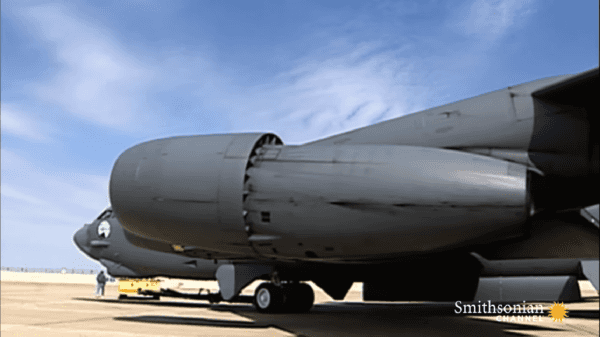One of the longest serving aircraft in the history of the U.S. Air Force came close to be forced into retirement more than 40 years ago.
In 1974, the U.S. Air Force debuted its newest Bomber, the Rockwell B-1A, the potential replacement of the B-52, after a long and distinguished service record. The B-52 faced a threat it had never encountered in combat: retirement at the hands of a newer, more advanced model.
The B-52 was an upgraded and revised version of the B-47. It came with “thicker wings and eight more powerful jet engines that allowed it to fly a range of 8,800 miles with air speeds of 650 mph, reaching altitudes of 47,700 feet,” according to Historyonthenet.

(Smithsonian Channel/Youtube)
Even though the B-52 was a behemoth in size, it was quite flexible. Air Force General Curtis LeMay established a strategy of keeping B-52s flying daily all year long so it would not be spotted on the ground, a strategy that continued through the late 1960s. After that, B-52s were kept loaded and on standby with crews nearby until 1991 when the Cold War concluded.
The B-1 Bomber was a better and more technologically advanced than the old B-52. Designed to beat the USSR in mind, its only drawback was the mammoth price at the time, which was $102 million. It had the capability to stay under Soviet radar, it could fly low and fast, with nuclear capabilities. It all came down to politics.
The price was a political battle and ultimately the B-52 kept its role. The rest is history.
During his presidential campaign and in an election year, Gerald Ford wanted to build the B1 Bomber, which would do away with the B-52 but his rival Jimmy Carter said he wanted to keep the B-52 program going. The future of the B-52 was going to come down to a vote. After Carter won the election, the B1 program was canceled and that gave the B-52 a new lease on life and justifiably so.

(Smithsonian Channel/Youtube)
The B-52 has the “capability of dropping or launching a significant array of weapons in the U.S. inventory, including gravity bombs, cluster bombs and precision guided missiles,” according to the Federation of American Scientists.
The bomber has been in continuous use by the Air Force since the 1950s because of its superior performance at high subsonic speeds and low operating costs. It can carry 70,000 pounds of weapons.
The B-52 is expected to remain in service through at least the 2040s.



